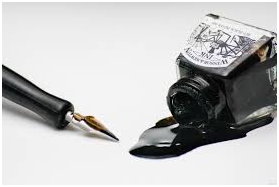The 'Qalam Dawat' Ink Fades
Spilt Ink?

SRINAGAR: By breaking his silence and hinting at partnering the Hindu Nationalist Bharatiya Janata Party (BJP) for possible government formation in politically sensitive Jammu and Kashmir, Peoples Democratic Party (PDP) patriarch, Mufti Mohammad Sayeed seems to have caused severe damage to his personal and the party’s reputation in the state.
This runs counter to PDPs much touted ‘healing touch’ policy and its political and economic vision of ‘self-rule’ and ‘self-reliance’.
PDP’s possible collaboration with the BJP will be largely interpreted as an “insult” to the voters’ verdict in the recently held Assembly Elections in Jammu and Kashmir, because the dominant perception in the Kashmir Valley remains that people voted in unprecedented numbers partly with an aim to put a full stop to Modi wave at Pir Panjal.
In the Kashmir Valley— the “graveyard of reputations”— the PDP may find its reputation, which the party built brick by brick over the last one-and-a-half decade, falling apart, because of its attempts to mix soft-separatist rhetoric with the BJP’s saffronisation only to grab power for next six years.
What the PDP leadership perceives as “political opportunity” is seen as “political suicide” by the common man on the streets.
How the PDP ‘succeeded’ in presenting itself as a regional force to reckon with and also as ‘viable’ alternative to ‘corrupt’, ‘complacent’ and ‘arrogant’ National Conference (NC) in the past 16 years or so makes an interesting analysis.
Mehbooba Mufti, Sayeed’s daughter and PDP President, paid regular visits to the families of slain Kashmiri militants in different parts of the disputed Himalayan region to express her sympathies and condolences. She sympathised with the family members and end up issuing statements to the press which would be very identical to press releases of the Hurriyat Conference.
Veteran Mufti Sayeed used to go a step further than his daughter Mehbooba in giving a “sense of accommodation” and “sense of achievement” to the voices within Kashmir who had lost all hope in the democratic process.
Sayeed’s statements were successful to some extent in occupying the space held by Kashmir’s resistance groups in the vernacular press. Many a time one struggled to try and detect a difference between the two.
One of Sayeed’s notoriously controversial statements in 2002 that “Kashmiri militants don’t need guns anymore because their representatives are now in the assembly” gave an impression as if the PDP was ‘hand-in-glove’ with the Hizb-ul-Mujahideen, Kashmir’s largest indigenous militant outfit.
The party never felt the need to clarify this impression, because it continued to reap rewards from ambiguity.
The case with the Jama’at-e-Islami (JeI), a cadre-based socio-religious and political group, was entirely different. Soon after the eruption of popular anti-India armed uprising in 1989 the JeI declared Hizb as its military wing only to distance itself from the armed group once the Indian army started cracking down on all militant groups in early 1990s.
When Mufti took over as Jammu & Kashmir’s Chief Minister in 2002 for three years as part of the then coalition government’s rotational CM policy, he was successful in taking the credit for some political initiatives and developments that took place between India and Pakistan. These included the re-opening of trans-Kashmir Srinagar-Muzaffarabad bus service after a yawning gap of 58 years in April 2005, then Indian Prime Minister Atal Bihari Vajpayee extending a hand of friendship to then Pakistan President Pervez Musharraf, and Hurriyat’s talks with both Indian and Pakistani leadership.
All such confidence-building measures (CBMs) and initiatives did change the perception of people in Kashmir to an extent and gave some of them a sense of achievement, too.
As the people of Kashmir were looking for a better alternative to the National Conference, a party which had earned bad reputation in the eyes of many Kashmiris for its anti-Kashmiri policies, the soft-separatist rhetoric came in handy for the PDP to hoodwink common Kashmiris.
For all these years since 1999, the father-daughter duo of Mufti Sayeed and Mehbooba Mufti played their cards smartly. With the proverbial single stone they aimed to kill two birds; one, replace the weak National Conference (NC) as a viable regional force; two, speak the language of Hurriyat Conference to stay relevant in Kashmir’s dominant political narrative.
This is how the PDP tried to achieve both goals.
First and foremost, the PDP borrowed its flag from the erstwhile Muslim United Front (MUF) — an amalgam of like-minded political, social and religious Kashmiri groups whose candidates were unceremoniously declared unsuccessful in the infamously rigged elections of 1987— and its symbol inkpot and pen (locally referred to as ‘Qalam Dawaat’) also helped it to create a niche for itself in Kashmir’s political discourse.
Unlike mercurial Farooq Abdullah, the PDP patron Mufti Saeed would refrain from issuing any anti-Pakistan-Hurriyat-Militant-Geelani statement and often repeat his favourite line that “democracy is a battle of ideas”. He started building his image as shrewd and mature politician who wouldn’t open his mouth unnecessarily. That perhaps was the stark difference between Abdullah and Sayeed, and as the locals say the former suffered from “diarrhoea of ideas” and the latter was a victim of “constipation of ideas”.
But the PDP’s efforts now to sell the present Indian Prime Minister Narendra Modi as AB Vajpayee to the Kashmiris is not likely to work because of the Gujarat violence that has branded him as RSS in the Valley, unlike Vajpayee who was perceived as a moderate.
The PDP seems to have moved from the healing touch policy and self rule to doing hard business with the BJP. The critical voices insisting that the PDP “is a party of the agencies” will become more strident and stronger now.



